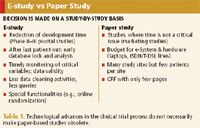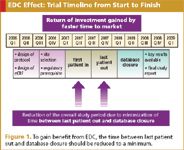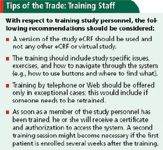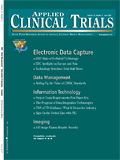Impact of EDC on Clinical Staff Roles
In addition to study timelines and budgets, EDC adoption directly affects the people who run trials.
What we want to gain from EDC systems has already been widely discussed: faster time to market as well as a smoother data query process without redundant queries—these are the most important benefits we expect from investing in EDC. If after implementation of EDC these benefits become reality, one can consider the decision to go with EDC successful.
However, the changes associated with the implementation of EDC might not lead to advantages in all aspects of the clinical trial process, which is the reason why there are still a lot of reservations about the use of EDC. In this article, I would like to focus on the changes the implementation of EDC brings to the clinical staff: sponsor study managers and CRAs, and study teams at the investigational site.

PHOTOGRAPHY: COMSTOCK
Challenges in the preparation phase
In the preparation phase of a study, the clinical team on the sponsor side has to find answers to the following questions, independent of whether an e-trial or a conventional paper-based trial is planned:
- How long will the trial take?
- What are the costs?
- How many FTEs (full time equivalents) are required?
Though there are significant differences between an e-trial and a paper trial with respect to timelines and budget, a reduction of manpower can only be expected in data management and not for clinical staff (see Table 1).

Table 1. Technological advances in the clinical trial process do not necessarily make paper-based studies obsolete.
The overall workload for study managers does not change when conducting an e-trial. It is a rule of thumb for most companies to assign one study manager for one clinical trial—especially in the case of pivotal trials necessary for registration. The same is applicable for e-trials. The time needed for tracking the use of eCRFs is often underestimated.
Whether a company is able to provide realistic timelines for e-trials in the planning phase of a study depends a lot on the e-clinical experience within the company, the level of standardization of processes, the careful tracking of milestones, the competency of the project manager, successful recruitment, and many other factors.
Especially in the setup phase of a trial, study managers may become irritated if it takes much longer than it would to set up a paper-based trial. A time period of four months for setting up a trial with EDC after availability of the study protocol is normal, whereas with paper CRFs, you might only need eight weeks for design and printing. However, the time you need in the beginning will be difficult to reduce, even if the processes are further improved. This is a result of the design and test phase of the eCRF, the technical equipment needed at the sites, and the training of the company and site personnel.

Figure 1. To gain benefit from EDC, the time between last patient out and database closure should be reduced to a minimum.
The level of accuracy in the design phase of an eCRF is directly associated with the overall duration of the trial. When an eCRF is created, great care should be taken not only for the design of the CRF entry screens, but also for the definition of the data validation plan. Every edit check implemented in the system and every query that can be avoided will result in a reduction of time and workload at the sponsor site and at the investigational site. This is the real measure of EDC's benefits. These benefits depend a lot on the people who design the CRF and edit checks in the beginning of the trial.
The check of the technical equipment of a site participating in an e-trial is more or less the task of the CRAs monitoring the sites. At the prestudy visits, they perform a technical site assessment: Is a laptop needed? Are new telephone lines or high-speed lines needed? The process of getting all sites technically equipped is time consuming. Although monitors may be in favor of EDC, the time necessary for monitoring, especially in the setup phase, can be considered a disadvantage and depends on the site's experience with EDC.
Design and costs
The development of particular eCRF pages will become easier the more EDC trials a company conducts. When designing a clinical study, there are EDC features that allow for exciting new opportunities for the trial process.
Adaptive trial designs are facilitated by eCRFs, since with these types of studies the time gap between subject examinations and availability of the data at the sponsor site needs to be reduced to a minimum. Furthermore, the possibility of assigning subjects to another treatment arm during the ongoing trial based on interim results of an adaptive trial can be implemented in the eCRF. Randomization can be integrated in eCRFs and dose adjustments (e.g., in insulin titration studies) can be guided with the help of the eCRF.

Tips of the Trade: Training Staff
Ideally, the eCRF consists of a set of standard CRFs used across all sponsor's studies and a set of study specific CRFs, which need to be created for each trial individually. One certainly can also think about a set of indication specific CRFs that could be assigned to all studies of a certain therapeutic area. If the data checks for these standard CRFs were also to be standardized, the time needed in the start phase of a clinical study could be further reduced.
The study manager should closely follow the design of the CRFs and data checks, especially since EDC providers sometimes develop eCRFs with programmers who do not have any medical knowledge. The subsequent user acceptance test is usually time consuming and might lead to a huge amount of changes in the CRF design and edit checks, which could have been avoided if there was closer collaboration between the clinical and technical staff.
The user acceptance test is a very important phase during the design of the eCRF. Ideally, in addition to data managers, study managers, and monitors, at least one investigator should be involved. Since only the user acceptance test and the succeeding changes might last one month, as many standardized CRFs and edit checks should be used and all parties previously mentioned should participate in the creation of the very first paper model of the eCRF.
When the study manager is going to prepare the study budget, he/she should be aware that the costs of an eCRF are usually higher than for a paper-based CRF. If a company manages to reduce the overall development costs of a product with the help of EDC, the earnings will outweigh these costs by far. In order to measure the real value of EDC, it is important for every company to carefully track the duration of clinical studies and associate them with the systems used.
The costs associated with the implementation of an eCRF are caused by the development of the eCRF, continuously needed user support, laptops, and telephone lines. An increase of the original budget might be caused by study amendments, other retrospective changes of the eCRF, further training needed for new study personnel, and, in case of recruitment difficulties, costs for additional study sites/hardware, increased costs for user support via help desk, and project management costs of the eCRF vendor.
If companies did not generate a master agreement with a vendor, contract negotiation for individual studies are definitely a further challenge. Here it is important to agree on an overall package that includes all services by the vendor, the final amount to be paid for the development of the eCRF, and possible cost factors in case the trial needs to be extended. Caution is advised with respect to the complexity of the eCRF, since the definite number of CRF pages needed is sometimes difficult to be estimated in the planning phase of a trial. However, a vendor should be in the position to provide a final offer for its services based on the study protocol. Agreement of costs based on any assumptions should be avoided in order to not exceed the original trial budget.
Data integration facts
The integration of central lab data into an eCRF should be considered carefully. In a less-experienced EDC environment, the technical transfer of the lab data might lead to delays in the design phase of the eCRF as well as during the ongoing trial—when lab data would need to be transferred continuously from a lab database into the eCRF. If a well-established solution is not offered by the vendor, I would prefer to integrate the lab data with the other study data outside the eCRF and only after the trial ends. However, integration of other electronic data sources like eDiaries and data from ambulatory blood pressure measurements, spirometries or central ECGs might be realized more easily. In more advanced EDC environments, integration with CTMS or clinical trial supply logistics might also support the clinical trial process.
Training considerations
When it comes to training, there are several options as to how this can be conducted. Centralized training can be organized at investigators meetings or at company training camps. Training the whole study group together has an advantage: Learning together might promote commitment to the study and the quality of the training is the same for all study participants. The disadvantage is that participants might be hesitant to ask questions, and such an event is costly.
The more cost-effective training approach is training of investigators and study nurses by site monitors directly at the sites according to the "train the trainer" principle. Here, costs only occur for the training of the monitor or for one monitor per country, who then trains the other monitors at the affiliates. A further advantage of this training approach is the fact that the training can be adapted according to the EDC experience of the site staff. On the other hand, the training may be poor, especially if there is no detailed guidance available to help the monitors conduct the training.
Investigators need to be trained even if they do not perform the data entry, since they have to endorse the credibility of the data. Certainly, brief training that allows the investigators to navigate through the system would be sufficient.
Benefits and drawbacks
Whereas the setup phase of an eCRF is still a challenge in most cases, some convenient features might become applicable during the conduct phase of a study. One major advantage for the study manager in this phase of the trial is the real-time access to study data that allows improved quality and safety control. However, to gain these benefits, processes should be defined on how to review the data during the running trial and how to check the performance of investigational sites with respect to speed and completeness of the data entered.
In order to fulfill these tasks, it is of utmost importance that the study manager assigns sufficient time for the performance and safety control during the trial. Innovative EDC systems already provide study progress reports, which allow identification of study sites with delayed or incomplete data entry. Ideally, SOPs should be installed to guide the study manager through the setup and conduct of an e-trial.
Continuous monitoring of clinical variables allows for early detection of common adverse events and early availability of safety data support decisions from Safety Monitoring Boards.
If any problematic study sites with delayed or incomplete data entry are identified, measures should be taken as soon as possible to improve the performance of these sites. To close the database as quickly as possible after the last subject has finalized the study, every effort should be made to solve any issues as early as possible during the course of the trial. Otherwise, the workload steadily increases toward the end of the study, and it may become impossible to resolve issues due to improper data entry without any delay to database closure.
Payment of investigator fees can be done visit-wise, based on completely entered patient visits. This is usually an inducement for timely entering of data.
For communication within the study team, some eCRFs allow continuous update of the eCRF homepage with study-relevant information. Not only standard documents like study protocols and amendments can be stored here, but also newsletters or organograms of the study team at the sponsor site.
For the site monitor, it is usually seen as a benefit that less time is needed for the query resolution process. Contrary, a lot of time is needed for technical aspects and leads to the necessity that beside medical and GCP knowledge, technical skills are also required. The review of the CRF at different locations in the hospital (investigator's office, room of study nurse, pharmacy) becomes more complicated as compared to paper CRFs. On the other hand, the monitor has to deal with less paper and needs less time for tasks like sorting and copying.
When introducing EDC, the tasks at the site certainly differ, mainly with respect to the means of data capture as compared to paper CRFs. Usually, the data entry tasks are assumed by a study nurse, whereas the investigator only reviews the data in the system prior to verifying its credibility. It is recommended to agree on reimbursement for data entry at the site (e.g., have a separate contract with the study nurse). Remuneration can be done based on each visit entered and the timely entry of data could also be integrated as a reimbursement factor.
ROI in the end phase
The end phase of the study needs to be planned as carefully as the start phase of the study, especially with respect to the timely aspects. In the ideal world, the database should be closed one day after the last patient's last visit. However, there are many obstacles to overcome to reach this ambitious goal. Things to avoid in order to prevent any delay in the end phase of a study include the following: backlog of data entry, a lot of manual checks and queries after all data are entered, holidays of monitors and investigators in the end stage of the study (for example, do not plan database closure during summer time).
First pilot studies , which integrate the safety database with the EDC system, are currently ongoing. If these systems are successfully combined, serious adverse event reconciliation at the end of the trial will become redundant.
Archiving of eCRF data is usually done on CDs or DVDs; therefore, the Subject's Trial Master file is reduced to a small box in the archive rather than several meters of paper folder. This is also an advantage appreciated by the investigational sites, since these are always limited with storage capacities.
Conclusion
Further development of e-solutions will lead to further changes in the role of the clinical team. On the sponsor side, the adaptation of trials according to study results gained during the active trial might help to overcome the gap between the classical Phase II and Phase III trials toward combined seamless Phase II/Phase III development programs.
Since clinical examinations are not standardized within and across countries, adaptation of eCRFs to the clinical setting remains a challenge. Ideally, CRFs should be divided in two parts: One part is filled in by the physician during the patient's consultation, and the other part is filled in by a study nurse during examinations, without interfering with the clinical routine.
The future of e-clinical offers many opportunities for improvements in the clinical trial process; however, successful implementation is dependent on the EDC experience of the clinical trial team.
Franziska Falk, MSc, is a clinical research manager at Astellas Pharma GmbH, Neumarkter Str. 61, 81673 Munich, Germany, email: franziska.falk@eu.astellas.com

Study Finds Many Randomized Clinical Trials Have Poorly Justified Exclusion Criteria
January 21st 2025Investigators find that most exclusion criteria in critical care randomized clinical trials are justifiable, but 60% include at least one poorly justified exclusion, most commonly affecting pregnant or lactating individuals.